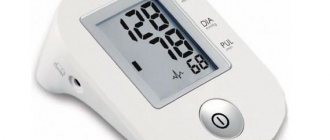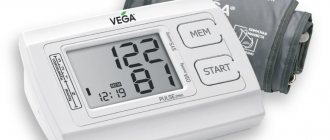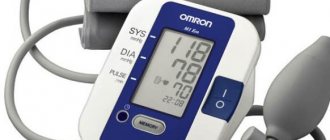Blood pressure is a kind of indicator. It shows the state of a person’s heart at the moment. It is not permissible to draw conclusions about health based only on the tonometer readings, but the readings of the device can give a signal if the heart begins to malfunction. And this means it’s time to contact a specialist. The device readings are encrypted into a special symbol system. Knowing what the numbers on a blood pressure monitor mean, you can prevent many serious conditions.
SYS and DIA numbers
Two numbers located one below the other indicate systolic and diastolic pressure. The first is measured during the ejection of blood or contraction of the heart muscle, and the second while it is relaxed. DIA (diastole) indicates the level of lower pressure, and SYS (systole) indicates the upper pressure.
Systole and diastole indicators on a tonometer
The normal rate is 135/85. Having seen such tonometer readings on the display, which mean the absence of hypertension and hypotension, you don’t have to worry about your health. For a more accurate result, it is better to take a measurement first on one hand and then on the other and calculate the arithmetic average of the two indicators.
Another significant factor is the difference between the upper and lower indicators. If the measurements show a difference much less or more than 50, then the user should report this fact to the attending physician.
A state of rest during diagnostics will help to avoid errors in the device readings. It is prohibited to speak or move until data appears on the device display.
Why does the tonometer show the pressure incorrectly?
Tonometers are special medical devices that measure blood or eye pressure. In the latter case, the device is called a pneumotonometer. Such devices are an indispensable attribute of doctors. However, today blood pressure measuring devices are successfully used at home by many people, especially those suffering from hypertension and heart disease. A tonometer is even recommended for them, because patients must always keep their blood pressure under control in order to avoid complications caused by increased blood pressure. Tonometer readings are recorded as two measurements, for example, 120/80 mm Hg. Art. What do these numbers mean? This is the different pressure created in each of the two phases of the heart. The first reading is the highest blood pressure pumped by the heart. In our example, it is 120 - it is called systolic. The second reading is minimal. It is observed in diastole, when the heart relaxes, fills with blood, and then pushes it out. This “lower” pressure is referred to as diastolic.
Heart rate
The third digit located on the device display is the pulse. This figure is located in the bottom row under the pressure indicators.
Heart rate indicator
It is not difficult to understand what this or that number located on various models of tonometers for measuring pressure means. Heart rate depends on the age and gender of a person; on average, this indicator varies from 60 to 90 beats in 60 seconds. A rarer pulse may indicate bradycardia, a more frequent pulse may indicate tachycardia.
Tonometer shows different pressure
There are situations when tonometers show different pressures. This may be due to the characteristics of the device itself, the time of day, and its readings also strongly depend on its incorrect use or non-compliance with the instructions. For example, for any person after a walk in the fresh air, the blood pressure monitor will show higher pressure than after 5 or 10 minutes of rest. This is normal, even doctors suggest that the patient sit quietly before measuring blood pressure. If you take measurements several times in a row, the tonometer may show different pressures. This is due to the fact that after the first check, the vessel walls compressed by the device did not have time to recover, and blood flow is still difficult. In this regard, it is recommended to re-measure only after 3 – 5 minutes. It should be borne in mind that some people, especially the elderly, need 10 to 15 minutes to restore blood vessels. Very often people ask why there is a difference in values between the measurements of an electronic and mechanical tonometer. On the first, they are 15 - 20 mm Hg higher. Art. even with parallel blood pressure measurements. This is explained simply: the electronic device is too sensitive to many changes.
Arrhythmia indicator
The arrhythmia indicator is an icon located on the device display. As a rule, it is located at the very bottom of the screen, closer to the center. Depending on the make and model of the device, the appearance of the icon can vary significantly, but most often this symbol looks like a flashing heart.
Arrhythmia indicator
The icon lights up if the heart rhythm is uneven. This may indicate both the arrhythmia of the human heart and interference that arose during the measurement.
In order to exclude a random factor, you need to repeat the procedure after a few minutes. If, during three repetitions performed while the patient is at rest, an arrhythmia icon appears on the display, the user should report this fact to the therapist or cardiologist as soon as possible.
How to fix the problem?
The bracelet-type tonometer often pumps air a second time
The automatic tonometer is sensitive to any fluctuations, so you should be especially careful when measuring pressure. Those who carry out the measurements themselves should follow all the conditions and recommendations specified in the instructions. In this case, the following rules must be observed:
Instructions for correct measurement
- sit comfortably on a chair, leaning on the back;
- hold your hand so that the cuff is at heart level;
- you cannot support the cuff with your second hand;
- Do not strain your wrist or hand;
- the wrist should be in line with the hand;
- you cannot clench your hand into a fist;
- It is not recommended to move or even talk while measuring blood pressure;
- place your hand with the cuff above your stomach, you can put it on the table in front of you;
- the cuff should be 3-4 cm above the ulnar socket of the joint;
- the hose should be in the middle of the elbow socket;
- the cuff is carefully tightened on the arm, with partial compression.
Correct location
Any extraneous movements can distort the indicators, as a result of which pumping often occurs a second time. If blood pressure is measured with a bracelet-type device, then you must follow the rules and recommendations specified in the instructions.
Repeated pumping of air by the tonometer is not a serious problem with the device, but may indicate significant health problems. To achieve the correct result, it is recommended to measure the pressure several times and take the average value.
Semi-automatic and automatic devices.
Previously, the main devices were mercury. Tonometer cuffs can be placed on the wrist or forearm during blood pressure measurement. Blood pressure is measured in millimeters of mercury (mmHg). But what to do if the tonometer does not show pressure, or gives different readings? And how to check the tonometer for accuracy?
To estimate blood pressure, you need to know the initial data, which looks like this:
- Low
blood pressure is considered to be in cases where the upper reading is 100-110 and the lower reading is 70-60 mmHg. Art.; - optimal
– 120/80 mm Hg. Art.; - slightly elevated
– 130-139/85-89 mmHg. Art.; - high
– 140/90 mm Hg. Art.
With age, blood pressure tends to increase due to changes in vascular capacity.
Normal pressure is considered at the following values:
- in 16-20 year
olds – 100-120/70-80 mmHg. Art.; - in 20-40 year
olds – 120-130/70-80 mmHg. Art.; - in 40-60 year olds
– less than 140/90 mm Hg. Art.; - over 60 years old
– less than 150/90 mmHg. Art.
To correctly determine blood pressure, the following rules must be observed:
- the patient should be in a calm and comfortable environment for at least 5 minutes;
- an hour before the procedure, he should not eat, drink or smoke;
- his bladder should not be full;
- after emotional outbursts, you need to wait at least an hour;
- do not talk during the measurement, sit up straight and have support under your back;
- do not cross your legs so as not to squeeze large vessels and prevent blood flow;
- the cuff should not dangle or squeeze the arm tightly;
- the cuff should be located at the level of the heart and two centimeters above the elbow.
Violation of the basic conditions for measuring blood pressure leads to erroneous values. The magnitude of the error can reach 20-25 mmHg. Art.
Users sometimes encounter situations where the tonometer does not show pressure. The reasons why the tonometer does not show pressure can only be determined by a specialist, and only a specialist can answer certain questions regarding the operation of the device.
Graphic blood pressure level indicator
It can be difficult for an elderly person to keep a few numbers in mind and remember what normal blood pressure should be. For such people, as well as for greater clarity, many tonometer models have a graphic indicator of the blood pressure level.
Graphic blood pressure level indicator
All manufacturers position the scale differently. For some brands it is located on the body, while for others it is on the display. Figure 3 shows a tonometer with a scale placed on the body. A slider on the screen is displayed next to the danger level. The position of the slider in the green zone means that the indicator is within the normal range; if the slider is in the red zone, you should consult a therapist or cardiologist.
High pressure indicator
Deviation of blood pressure readings from the norm is a serious signal that may indicate heart disease. And the treatment of such diseases must be approached without delay. That is why on the displays of some tonometer models there is an additional icon that signals high blood pressure.
Tonometer with high pressure indicator
Motion indicator
On some tonometer models there is a motion indicator on the display. As a rule, it depicts a human figure.
Motion indicator
Movements while using the device can cause the device to display incorrect data, which in turn will lead to an error in diagnosis. The appearance of a motion icon on the device screen encourages the user to assume a state of rest and take the measurement again.
Indicator of correct cuff fixation
A correctly attached cuff to the forearm is half the success of obtaining accurate readings when measuring blood pressure. If you fasten the cuff looser than necessary, too tight or at the wrong level, the patient may cause pain and also delay the diagnostic process.
Example of correct cuff attachment
To avoid this factor, the display of many tonometers includes an icon for correct cuff fixation.
Indicator of correct cuff fixation
For the manufacturer OMRON, this icon looks like the abbreviation OK enclosed in a circle. The presence of an active symbol indicates correct fixation of the cuff.
What is decompression in a tonometer?
One of the interesting applications of modern MK is, of course, medicine.
The range of devices here is quite wide, ranging from simple thermometers, where you can use a simple STM8L with an LCD screen, to sophisticated cardiac monitors, ECG meters, holters with the ability to remotely collect and send information via Ethernet or wirelessly from patient beds directly to the head doctor’s office . Today we will talk about the possibility of using the STM32 MK for non-invasive blood pressure measurement using the oscillometric method. I ask all interested persons under cat.
Introduction
Today, the “gold standard” for measuring blood pressure is considered to be the “N.S. tones” method. Korotkov”, recognized by the World Health Organization. However, we should not forget that this is an indirect method of measuring blood pressure.
Of course, blood pressure measurement occurs with some error, determined by the elasticity of the walls of the artery and soft tissues, the amplitude and shape of the pulse wave, and other factors individual for each person.
If we abandon rounding and accurately use the division value of the pressure gauge, we will see the difference between adjacent measurements and when using a mechanical device.
Reading the pressure gauge readings by ear is also performed with some error, depending on the individual characteristics of the person - reaction speed, availability of skills, etc.
As a result, the error of manual tonometers consists of three components: the method itself, the accuracy of the pressure gauge and the error in determining the moment of reading the readings. In reality, its value can be up to 15 mm Hg. Art.! The measurement results are also influenced by the rate of air inflation into the cuff, the rate of deflation and the amount of pressure created in the cuff. If you add natural fluctuations in blood pressure, the difference between two adjacent measurements can be even greater.
An electronic tonometer, in principle, should have been free of all these disadvantages, because Tones are measured using the cuff itself, and processing is carried out using a number of patented algorithms and techniques.
As a result, today people have a strong opinion - “electronic blood pressure monitors lie - no one can measure blood pressure better than a doctor with a mercury blood pressure meter!” Experiments have shown that the large measurement error is caused solely by the average person’s inability to use this device, namely, to put on the cuff correctly. A correctly worn cuff is the key to obtaining a good envelope of Korotkoff tones and successfully finding characteristic points on the envelope.
Where to dig
There is a lot of literature on the method of finding blood pressure using the tone envelope on the Internet [1], [2], [3], [4], [5]. Freescale even has a nice appnote that popularly describes how to measure Korotkoff sounds in a cuff. But! There is practically no information anywhere on how exactly to analyze the resulting envelope.
Each manufacturer of tonometers sculpts them in their own way, although the general methodology is clearly visible. Just go to freepatentsonline.com and type non-invasive blood pressure in the search box, and you will get enough information to write a template for a tonometer. But! It gets worse.
Extrasystoles, artifacts, and other scary words get in the way of accurate oscillometry results...
Smart Metering Technology
If there is a heart-shaped icon on the device’s body with a curve intersecting it and the signature “Intellisense,” then the tonometer is equipped with intelligent measurement technology.
This technology provides readings during the process of pumping air into the cuff. This fact provides maximum comfort for the patient, because... eliminates the possibility of re-inflating air, as well as over-tightening the cuff. A device with Intellisense technology takes less time to measure blood pressure, and also eliminates possible painful sensations from squeezing the hand, thereby ensuring maximum accuracy of the data obtained.
Tonometer with Intellisense technology
Knowing how to decipher the tonometer readings guarantees timely diagnosis and detection of certain diseases of the circulatory system, and early diagnosis, in turn, guarantees a more successful treatment result and the prevention of painful and serious conditions.
What does the decompression symbol on the tonometer mean?
In order to know what the numbers on the tonometer show, it is important to be able to correctly decipher the readings.
Category Systole Diastole
| Optimal | {amp}lt; 120 | And | {amp}lt; 80 |
| Normal | 120–129 | and/or | 80–84 |
| Increased | 130–139 | and/or | 85–89 |
| Stage 1 hypertension | 140–159 | and/or | 90–99 |
| Stage 2 hypertension | 160–179 | and/or | 100–109 |
| 3. stage of hypertension | ≥ 180 | and/or | ≥ 110 |
| Isolated systolic hypertension | ≥ 140 | And | {amp}lt; 90 |
Main types of tonometers and their structure
To date, many devices have been developed for measuring blood pressure. The photo shows different types of modern tonometers. Let's take a closer look at them.
A mechanical tonometer consists of a bulb, a dial and a cuff, connected by rubber tubes.
The advantage of this type of device is its low cost, absence of errors against the background of arrhythmia, movements, and conversation. The disadvantages are that measuring pressure mechanically requires skills and a stethoscope. There is no arrhythmia indicator on the tonometer. An unreliable result may be obtained due to the patient’s decreased hearing, weakened tones, or tachycardia.
Mercury tonometer. The difference between this device is the mercury manometer. Used in some medical institutions, it is considered the most accurate. A clear disadvantage of this type of equipment will be the toxicity of mercury.
Automatic blood pressure monitor. Consists of a cuff and a recorder with a digital screen.
Such modern devices measure blood pressure, pulse, and can also be equipped with an indicator of arrhythmia, movements, and an indicator of the correct position of the hand. Some electronic models have a built-in printer.
The presence of built-in memory allows you to save data for a long time. The disadvantage of the device is the need for charging and the error in the measurement results.
The device can be mounted on the shoulder (shown above), as well as on the wrist and finger.
Finger device. In addition to blood pressure, the tonometer allows you to measure blood saturation (oxygen saturation) and pulse. The device reacts instantly after putting it on your finger.
Semi-automatic tonometer. It is an intermediate option between the two above. It has a bulb, a cuff and a digital screen with buttons. The undoubted advantage of this device is that the device has different functions and does not require charging or batteries, but the disadvantage is the need to use physical force when pumping air.
How it works?
If the indicator is triggered, it is worth repeating the measurement.
Against the background of arrhythmia, the measurement can be reliable or unreliable. A reliable indicator is displayed on the monitor along with an arrhythmia indicator, and if the data received is unreliable, the result is not displayed.
The symbol “E” (Error) appears on the display if the electronic tonometer cannot distinguish the pulse wave and estimate the pressure (when the heart contracts ineffectively, which occurs with atrial flutter and fibrillation). However, many modern blood pressure monitors have built-in software that can detect atrial fibrillation. For example, AFIB technology from Microlife, Duo Sensor from Paul Hartmann and others.
The diagnostic value of the arrhythmia indicator is high, especially in elderly people suffering from coronary heart disease.
24-hour blood pressure monitoring has been recognized as the gold standard in the diagnosis and treatment management of hypertension over the past few years as it provides an overview of absolute values and blood pressure variability over a period of time. Compared to random measurements, daily monitoring has a number of advantages:
- greater accuracy;
- reliability;
- reproducibility;
- automation;
- closer correlation with changes in organs.
Today, fully automated tonometers equipped with a number of technical amenities are used to measure blood pressure. They work on the principle of oscillometry and auscultation using the classical Korotkoff method. The patient wears a tonometer located in a sheath on the torso; the cuff with the measuring probe is located above the brachialis muscle.
The measurement frequency is user-defined; recordings in the waking state vary between 15–30 min; in sleep, the intervals are longer (30–60 min). Individual measurements are stored in memory and can be reproduced in the evaluation unit or processed by a computer.
On a computer, the display and interpretation of indicators is presented both digitally and graphically in the form of histograms, systolic, diastolic, average values, and heart rate curves. An analysis of maximum, minimum, and average values is also carried out.
The patient keeps temporary records of subjective problems and treatment, which are compared with pressure readings.
Cuff fastening indicator
The cuff is an important part of the tonometer. Available in both standard sizes (22–32 cm) and universal (22–42 cm):
- Standard – designed for patients with normal hand size. In this case, a one-size-fits-all would be inappropriate.
- Universal - suitable for cases where pressure will be measured by several people with different arm widths, or for people with large arm volumes.
Universal size available in 2 versions:
- CC is a thicker, preformed cuff that makes it easier to use. However, this type may be uncomfortable for some groups of people (such as the elderly) because their muscles are not as well developed and the complex design may cause soreness.
- CW – soft extended cuff. It adapts to any hand, is easy to use, and tightens well. But it is not entirely suitable for people with normal arm size, because it is too long.
- children's - CS (12–22 cm);
- standard – CM (22–32 cm);
- large – CL (32–42 cm);
- comfortable – CC (22–42 cm);
- soft extended – CW (22–42 cm).
The colored cuff fixation indicator (LED next to the display) indicates an error due to improper (for example, insufficient) tightening of the cuff.
The indication depends on the type of tonometer. Some have a color signal:
- green – reliable tightening;
- no signal – poor tightening (it is necessary to tighten or place the cuff correctly, repeat the measurement).
For other devices, the following symbol appears on the tonometer display: err cuf – cuff seal error.
Source: https://ooo-medpraktika.ru/blog/simvol-dekompressii-tonometre-oznachaet/










